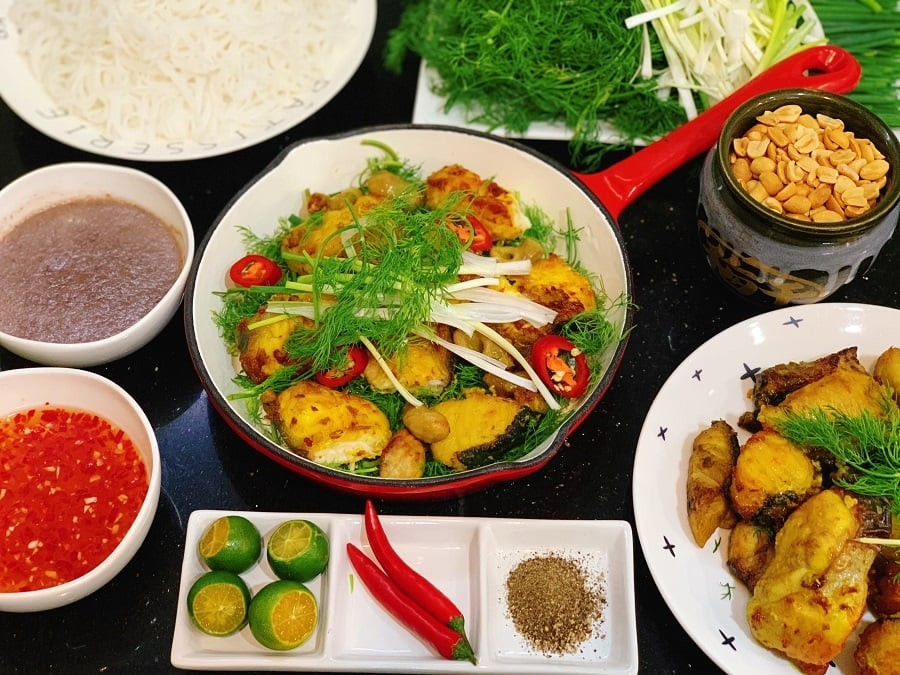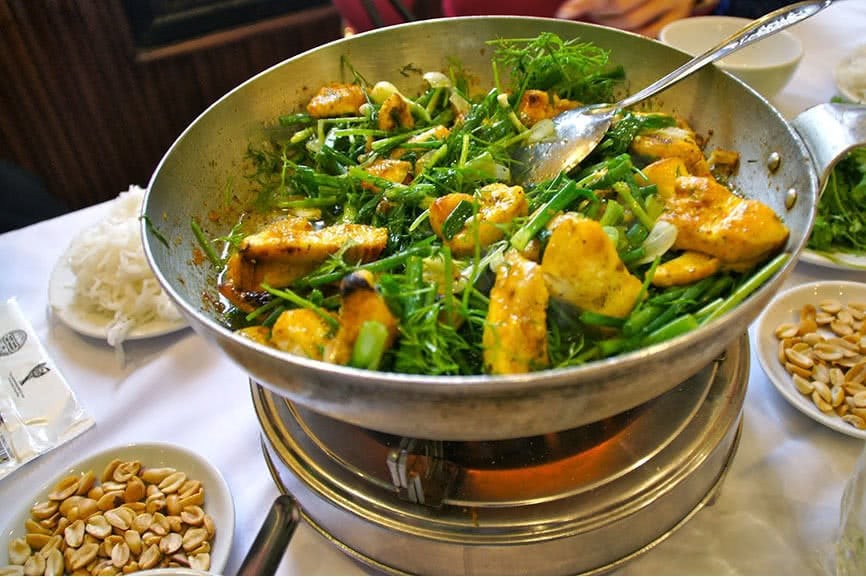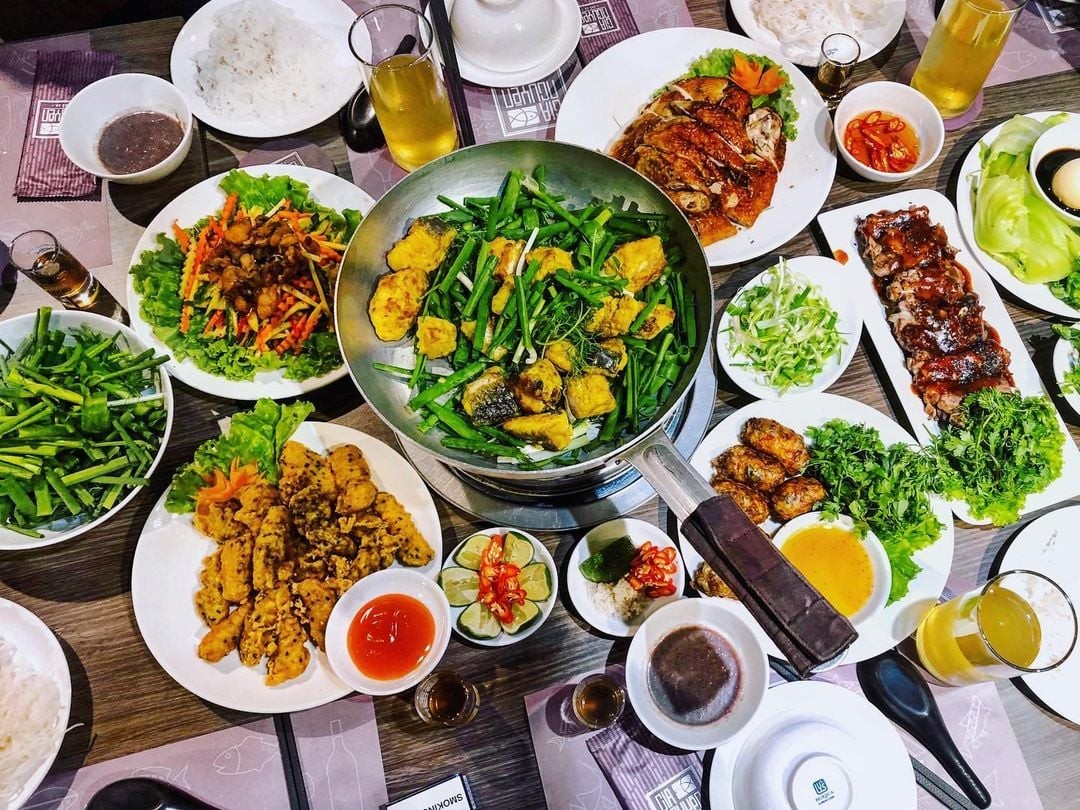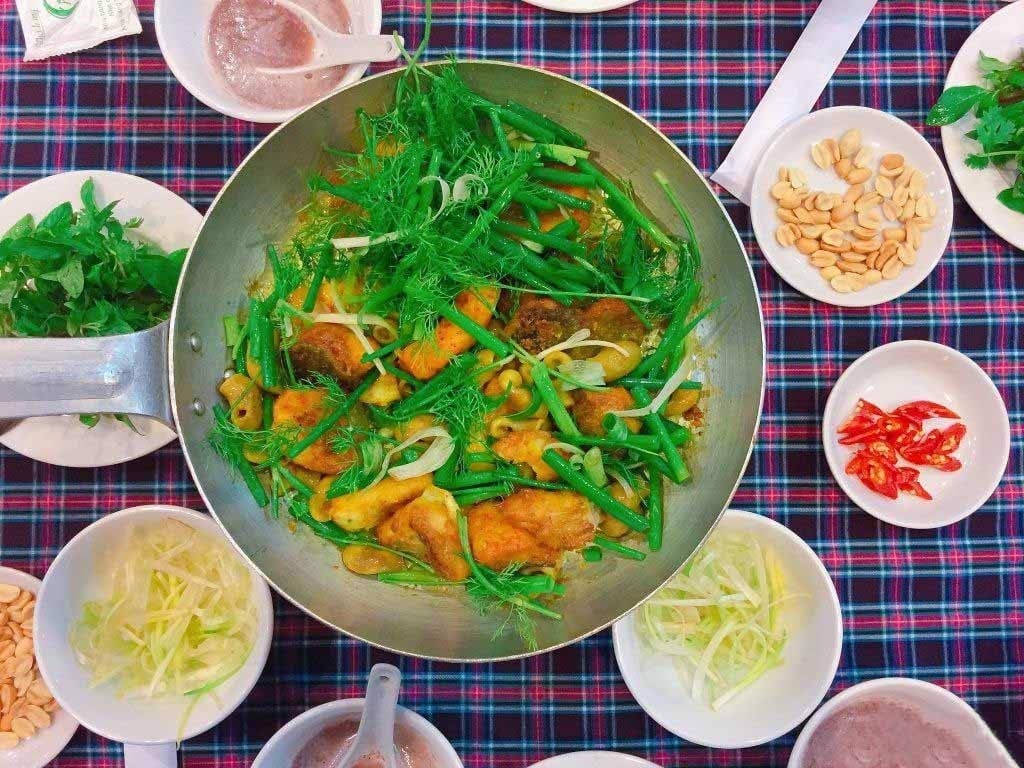According to Ben Groundwater, a seasoned culinary tourism writer with over two decades of experience in Australia, Cha Ca La Vong is a must-try dish when visiting northern Vietnam.
Cha Ca La Vong is a classic Hanoi dish, featuring chunks of freshwater fish, typically catfish, marinated in a blend of spices including turmeric, and then fried to perfection. It is often served with an abundance of fresh dill, spring onions, peanuts, and rice noodles.

|
| Turmeric fish with dill and scallions is a famous Vietnamese delicacy. Photo: Vinpearl |
In 2019, CNN also recognized Cha Ca La Vong as one of the essential dishes to try in Hanoi, praising its unique combination of flavors.
The dish has a rich history, dating back to when Vietnam was part of French Indochina. The Doan family started selling grilled fish, which became a front for resistance fighters battling colonial powers.
Today, the Doan’s restaurant, located at 14 Cha Ca Street in Hanoi’s Old Quarter, remains a popular destination for tourists and locals alike. However, it is essential to be cautious as many imitations bear similar names.
Cha Ca La Vong is a traditional Vietnamese grilled fish dish hailing from Hanoi. It is typically prepared with hemibagrus, a type of catfish, marinated in a turmeric-based sauce, and grilled over charcoal.
The dish is served in a hot pan with a generous amount of marinade sauce and herbs, especially dill. It is commonly accompanied by vermicelli rice noodles and peanuts, elevating it to a true culinary delight.

|
| Enjoying turmeric fish with rice noodles and herbs in a traditional setting is an unforgettable experience. Photo: Vinpearl |
The Doan family has a long history of preparing grilled fish for their community. In 1871, with the support of their neighbors, they established the Cha Ca La Vong restaurant. The name “Cha Ca” translates to “fish sausage,” and “La Vong” pays homage to a local statue of Jiang Ziya, symbolizing patient and talented individuals.
Cha Ca La Vong was initially located on Hang Son Street in Hanoi’s Old Quarter, and it served as a gathering place for anti-colonial rebels. However, it eventually gained popularity among aristocrats and colonial troops, leading to the street’s renaming to Cha Ca.

|
| A mouthwatering dish of turmeric fish with rice noodles and herbs served at Cha Ca Vong Ngu. Photo: Vinpearl |
The original Cha Ca La Vong restaurant still stands in Hanoi, serving only its signature dish. Guests dine at communal tables, enjoying the sizzling flavors of the freshly grilled fish. The restaurant has even been featured in the book “1000 Places to Visit Before You Die.”
Cha Ca La Vong has captivated food critics and bloggers alike. Florence Fabricant describes it as “an intriguing combination of muskiness and freshness, with a silky texture and a burst of flavors.”
While the traditional recipe calls for hemibragus, some chefs have adapted the dish to suit local tastes and ingredient availability. In the United States, for example, various fish types and cooking styles are used, showcasing the versatility of this Vietnamese delicacy.

|
| Vietnamese turmeric fish with dill, served at Cha Ca Duong Thanh, is a culinary delight. Photo: Vinpearl |
Turmeric fish pairs perfectly with vermicelli and a dipping sauce. Fresh dill and other Vietnamese vegetables enhance the dish, creating a harmonious blend of flavors and textures. The fried fish and dill are artfully presented on a bed of vermicelli, topped with spring onions and crunchy peanuts, inviting diners to indulge in this culinary masterpiece.
When dining at a traditional Cha Ca restaurant, expect a hot pan of marinated fish to arrive at your table, along with an array of accompaniments. As the fish sizzles and the aroma of dill fills the air, you’ll understand why this dish has endured for generations.
The Ultimate Guide to Vietnamese Street Food: A Taste of the Real Vietnam
Taste Atlas, a globally recognized authority on culinary delights, has shed light on some of Vietnam’s most delectable street snacks. According to this esteemed website, deep-fried glutinous rice balls, known as “Banh Ran,” are a must-try. These crispy treats, with their chewy texture and sweet fillings, are a beloved local favorite. Accompanying Banh Ran on this prestigious list are banana cakes or “Banh Chuoi,” offering a delightful blend of sweet and savory flavors. The Sapa chestnut cakes, or “Banh Hat De,” provide a unique twist with their nutty aroma and delicate texture. Last but not least, the sugared or salted fruits, known as “O Mai,” offer a burst of freshness with a sweet or savory kick, showcasing the country’s vibrant and diverse street food culture.
Taste Atlas: Spring Roll and Sugarcane Shrimp—A Dynamic Duo of Appetizers Taking the World by Storm
Spring roll and sugarcane shrimp (Chao Tom) are not just any ordinary dishes – they are culinary ambassadors of Vietnam, voted among the world’s best appetizers on Taste Atlas’ global list. These traditional delights have earned their place as iconic starters, capturing the hearts (and taste buds) of food enthusiasts worldwide.
The Capitalist’s Cookbook: Hanoi, a Culinary Capital Unveiled.
Hanoi has been voted one of the top 15 culinary destinations globally by travelers on Tripadvisor, and it’s easy to see why. The city boasts a vibrant food scene with a unique blend of flavors and a rich cultural heritage that comes alive in its cuisine. From the humble yet iconic pho to the exotic and diverse street food, Hanoi offers a culinary journey like no other. It’s a food lover’s paradise, where every bite tells a story and every dish is a celebration of Vietnam’s vibrant culture and history.









